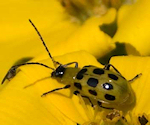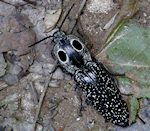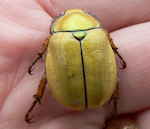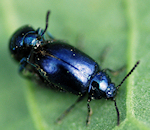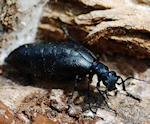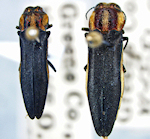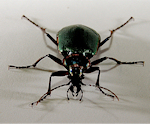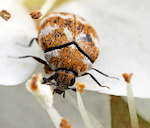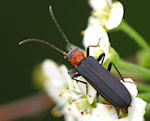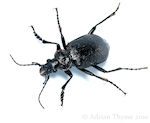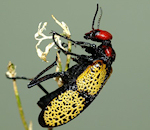I fondly remember those summer road trips from when I was but a young lad. Sometimes countless days spent driving the interstate highway system, thanks to which it’s now possible to travel coast to coast without actually seeing anything. But as a child there was plenty to see. Each time we climbed in the car it seemed like another big adventure, an opportunity to see the world.
As temperatures have warmed these past few months, the idea of a road trip has settled in my mind like an old friend. It calls to me with promises of miles of open country, new discoveries around every bend, fond memories when at last I return home.
So to marry that delightful idea with An Inordinate Fondness, the celebration of all things beetle-icious, I thought perhaps we could take a little drive together and see what we can see.
The ice chest is packed with drinks and snacks. There are coloring books available if you get bored. And remember: I don’t want to pull this car over, so let’s behave.
Now that all the seat belts are fastened, we’ll be on our way.
Our first stop is about 30 minutes north of Dallas. We’re stopping by to visit my friend Amber. She said recently that she’d discovered her macro vision.
Well by golly it appears she has! She found beetles and true bugs and flies and a whole world of neat stuff hiding right there under her feet. Now we’ll never get her out of the yard.
But time waits for no one, so we have to finish our lemonade and get back on the road. Did everyone go to the bathroom? I don’t want to have to stop in fifteen minutes.
OK, say goodbye to Amber.
Getting to Georgia takes a bit of time, sure, but it’s worth it. Joan has run across an eyed click beetle. Take a gander at that handsome insect.
Are those real eyes on its back? No, they’re not. They’re intended to fool predators.
Aren’t you the little comedian! Yes, they do make a nice fashion statement.
Wave bye to Joan. Now we’re off to North Carolina.
Swampy found a goldsmith beetle loitering about on her patio. And what a gorgeous critter it is! Looks like a polished gold nugget.
I know everyone wants to go canoeing with Swampy, but she’s a busy woman and we have a long trip ahead of us. Let’s pile in the car because I hear tell there are other fascinating finds on down the road.
Unfortunately now we’re going to backtrack a bit as we head to Missouri.
Shelly said she had something we simply have to see.
Oh my! Shelly, this is a family-friendly program. Well, yes, you’re right. Kids have to learn about the birds and the bees—and the beetles—at some point in their life. And green dock beetles are beautiful enough to make it look like living art.
Be sure to thank Shelly for inviting us over to see this. And be sure you tell your parents that it was her idea to show you that first image.
OK, moving along.
What’s that, Shelly? You have something else to show us? This is a treat!
Very nice… An American oil beetle.
That’s quite a compelling ruse the young put on. I didn’t know that before. I suppose clustering together on a flower and looking and smelling like a bee would be a pretty good defense for young beetles.
While we’re here in Missouri, let’s stop by and visit our friend Ted. He seems all worked up about something and I think we ought to see what the fuss is about.
Did he just adamantly declare that Josef Knull was wrong? Brave words. OK, Ted, show us the proof.
Well I do declare! Ted, I think you’re right and Josef was wrong. What makes it even more compelling is the rarity of the find and getting a new state record out of it based on Knull’s own specimens.
Sorry we have to run. Still plenty of places to go. Bye, Ted.
Yes, he is a very smart man, but don’t tell him that or it’ll go right to his head. We already may never hear the end of his having corrected Knull.
Finally made it to Illinois. Dave says he has a mighty fine goodie for us.
Holy cow! A fiery hunter. Just look at those rich colors and that iridescent shine. This is a beetle dressed for a night on the town.
Yes, I know it’s eating that grub. That’s what these beetles do. Life is always a game hunt and be hunted. It’s good you understand that.
Now say goodbye to Dave. We’re off to visit Alex just down the road.
Are you kidding? Carpet beetles, one of the most common insects, and so few have been collected? That is a funny tale.
I must admit I see them frequently. They like hanging out on the window screens. They’re almost small enough to slip through them.
Regrettably we have to run now, Alex. There’s still lots of driving ahead of us.
Where are we heading to now? Ontario.
The Geek in Question has been quite busy of late, but she’s never too busy for shiny.
Oohs and aahs all around. She’s found lots of shiny.
Great observation! Yes, that first beetle really does look like it’s doing an impersonation of an ant.
You like that red collar on the false blister beetle? When seen from behind it does look like Dracula’s cape.
One more quick glance at the lady beetle, then we have to go. Seabrooke is waiting for us.
This is why I said you didn’t need to dally over the lady beetle. Seabrooke found one, too. Isn’t she nice to explain that it’s so common here in Ontario?
Ha! No, I don’t think they’re all women. Didn’t you ever see “A Bug’s Life”? Then we’ll rent it when we get back to Dallas.
The time has come to say goodbye to Seabrooke. We have a long drive coming up. We’re heading to Alberta to see Adrian.
He found a ground beetle. And a rather attractive one at that.
What? Oh, did you hear that, poppets. It’s a hunter and a killer.
That’s a terribly insightful comment. The little mite does indeed look like a bejeweled decoration. That color contrasts well with the beetle’s dark hues.
Everyone wave bye to Adrian. Now we’re on our way to Colorado. It will be a long drive, so everyone visit the bathroom before we go.
No, we’re not there yet.
Nope, still not there.
No, it’s going to be a wee bit longer before we arrive.
Didn’t you go when we stopped to get gas? Well can you hold it for a few minutes? Good, we’ll stop as soon as we can.
Finally made it… I’m exhausted, but there’s no time to rest. Matthew and Heidi have a gift for us: an ironclad beetle.
Isn’t it fantastic? Looks just like a toy.
What was that? That’s so delightful! It plays dead, eh? Now that would be something to see.
And how right you are: they’re unmistakable and gorgeous.
I wish we had time for lunch, but we have one more long drive before we turn toward home. Where are we going now? Arizona.
Margarethe has invited us to see a nice collection of beetles. Or in the parlance of The Geek in Question, a big collection of SHINY!
Oh my… They are stunning insects. Such a diverse group.
I can’t stop snickering at the inflated beetle. It’s so fun to look at.
Seems like another good time to discuss the birds and the bees and the beetles. I may never hear the end of this from your parents. What kind of road trip did I take you on…
If you’ll say goodbye to Margarethe now, we’ll get on the road. It’s finally time to go home.
We’ve traveled many thousands of miles and have seen many marvelous things. I’m so glad we decided to do this. Nothing says summer like a long drive and plenty of opportunity to enjoy nature’s bounty.
Now I’m ready for a nap…
— — — — — — — — — —
The next edition of An Inordinate Fondness will be hosted by Seabrooke at the Marvelous in Nature. Get your entries to her no later than June 15, 2010.









